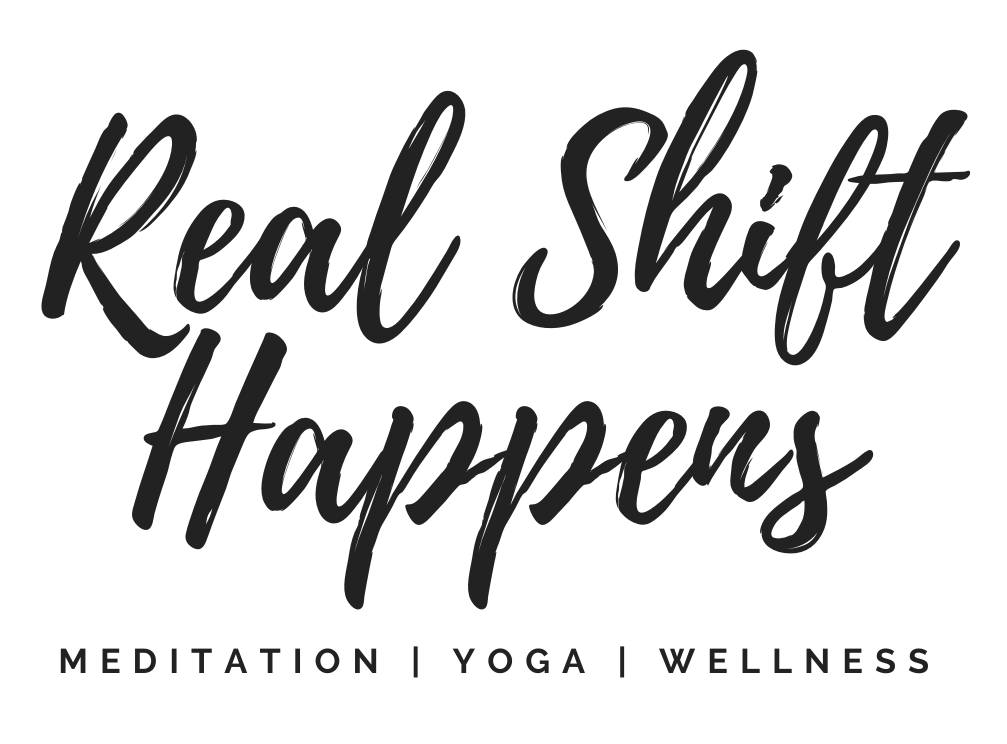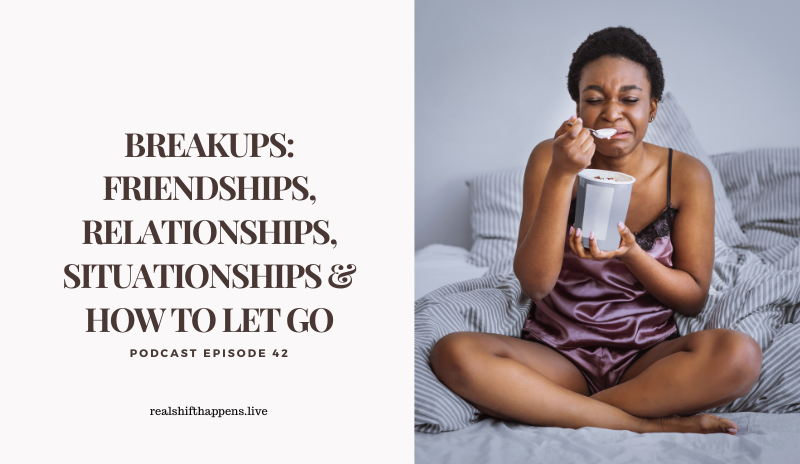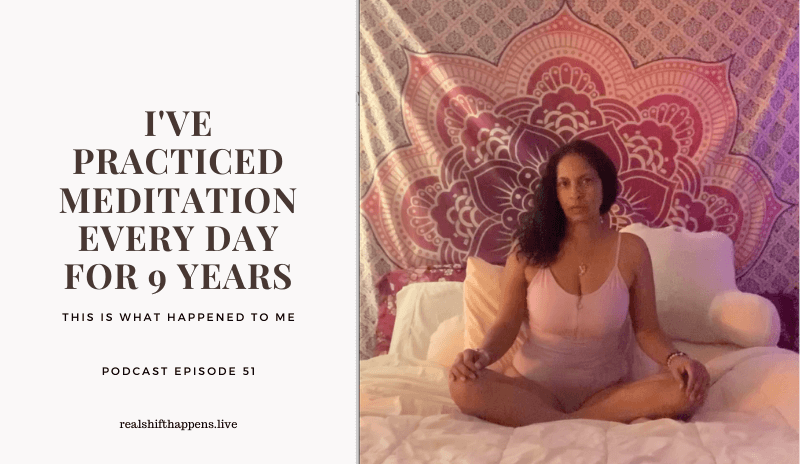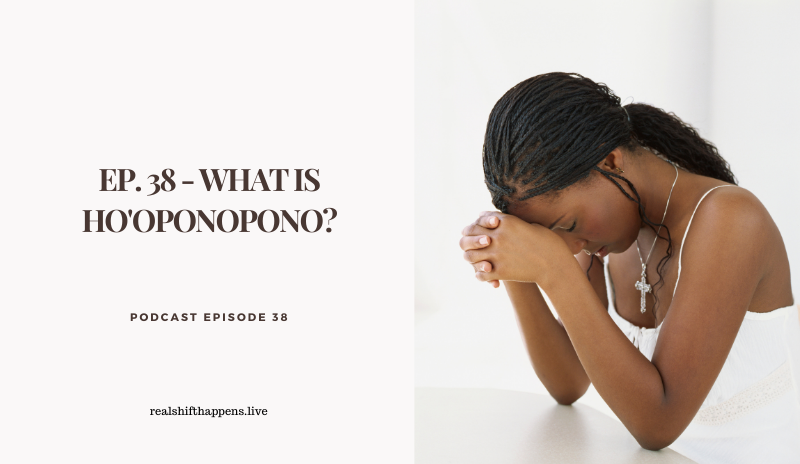And how to let go.
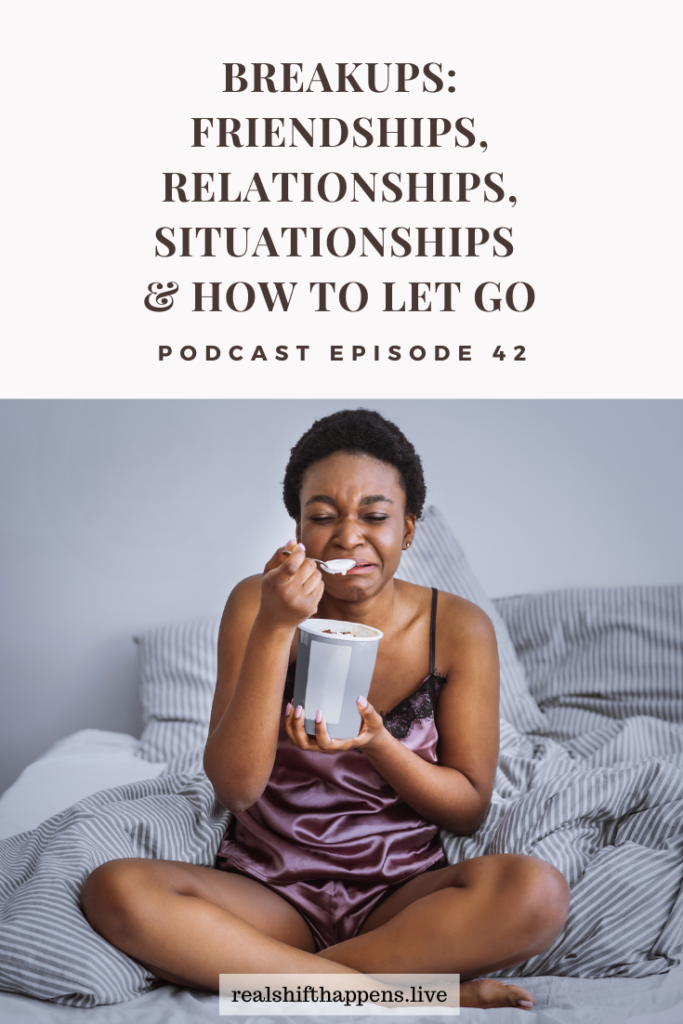
Peace and blessings. In this episode, we’re talking about breakups with friendships, relationships & situationships, all the “ships” and how sometimes the ships break apart.
We’ll touch on attachment styles, talk about 10 signs relationship red flags and four ways to deal with the breakup.
Listen to the podcast and keep scrolling.
Breakups
It’s never easy to break up with someone or to be broken up with whether it’s a more serious relationship or marriage, friendship or situationship but there are times when we know it’s the end for obvious painful reasons. And other times it’s hard to even come to terms with breaking up because you still really care about the person.
Whatever the case, there are usually signs in the relationship that let us know it’s coming to an end. And at times we don’t want to let go even after the relationship is over. We become attached to the relationship, the person, and/or the feeling they give us. And therein lies the danger.

Two Dimensions of Attachment Styles
There are basically four attachment styles in relationships and these are formed with the mother or primary caregiver by the type of relationship established with the young infant. This early relationship continues to impact our adult lives and is visible through our fears and insecurities and how we deal with them.
Attachment styles is really a topic for a whole other episode, check out work from John Bowlby and Mary Ainsworth to get more in-depth on the research of this framework.
Their research has shown there are two dimensions on which the four attachment styles develop. One dimension is attachment-related anxiety. Those who are high on this dimension are more insecure and worried about their partner’s availability and attentiveness. The other dimension is attachment-related avoidance. Those who are high on this dimension have difficulty opening up and being vulnerable with their partner.

The Four Attachment Styles
These two dimensions give rise to the following four attachment styles are:
- Secure Attachment
People who have a secure attachment style score low on both anxiety and avoidance. They trust that their partner will be there for support when they need it and they offer the same in return. They know how to express their wants and needs and are confident and optimistic about the stability of the relationship. - Anxious Preoccupied Attachment
People with an anxious preoccupied attachment style are high on the anxiety dimension but low on the avoidance dimension. They have trust issues and are more worried about the relationship. They need reassurance that their partner really wants to be with them and may become jealous, pessimistic and full of conflict. - Dismissive Avoidant Attachment
People with dismissive avoidant attachment style are high on the avoidance and low on the anxiety dimension. With this style the person is usually aloof, emotionally distant and claims they have a fear of commitment. They generally always have to be getting individual activities like work, hobbies, or social activities that don’t involve their partner. They may be more self-absorbed and passive-aggressive. - Fearful Avoidant Attachment
People with fearful-avoidant attachment styles are high on both avoidance and attachment. They both fear and desire an intimate relationship. They want the support and security of the relationship but at the same time fear rejection and worry about being hurt by their partner. This can result in inconsistent behavior from day to day which can lead to chaos in the relationship.
And this is not really an either or thing, there can be a mix of the later three involved. Many times there is an attraction between people with sort of opposite attachment styles.
For example, a person who has an anxious preoccupied style might attract a person with an avoidance style. In the beginning it all seems great like most relationships do but especially in this case, once the true attachment styles come out it will lead to a vicious cycle.
The anxious preoccupied person is triggered by the dismissive avoidant person and vice versa. The anxious person wants more “us” time and the dismissive person wants more “me” time.
It can become an anxious-avoidant attachment relationship cycle. Where the avoidant person needs space, then they get lonely in that space and wonder about you and think they made a mistake in taking the space.

So they contact you again, you being an anxious type, are happy as can be and fall for it everytime. And it’s all good. Until the avoidant starts to feel like things are little too intense and they need space again. Fights, breakups and makeups, just to repeat the same cycle.
I can definitely say I have been on some part of the spectrum of both anxious and avoidant but mostly the anxious attachment side with codependency issues. So this is a major lesson for me. I’ve been in this type of relationship probably my entire life and even up until recently. And I’m this years old before I even learned about attachment styles and started to realize my own attachment style.
This I discovered only in the past year since Covid hit during which time I had been seeing someone and learning so much about myself and how I operate in a romantic relationship. I definitely have room for growth in this area and even in all of my relationships to develop a more secure attachment style.
I will say that I have grown a lot in recognizing some of my unhealthy attachment styles, my toxic traits and being able to apologize when I’m wrong.
In the past, I always felt like I was just way too crazy to have a good relationship. And I probably was because I didn’t care enough to try but now I’m more self aware and I actually care about people’s feelings and want a healthy, stable relationship.
Although this past situation did not work out, I’m grateful for the time spent, though it probably lasted longer than it should have. The time has come to let go. And I am open to working on myself to attract someone who is equally yoked. I am cutting the cord to the drama by becoming more aware of what I really want.

The other breakup I recently had was a major argument with someone I called a friend for over 30 years and now we are no longer friends. After so many years, I had to look back and wonder if I’ve just been in a long term attachment to someone due to the history.
I wonder if this is a relationship that should have ended years ago but I just held on to it for fear of losing it. Yes, we were great friends at one point but at some point we started to grow apart. And once that happened, the relationship was over but the attachment never ended. Until now. Now because I’m really learning that I have to let go.
Sometimes it’s difficult to face the fact that a relationship is over and we simply ignore the signs or we don’t even know there are signs because our need to keep this person in our life keeps us blinded from the truth.
I’m not saying it’s always one person’s fault and the other person is innocent. However, there are characteristics and red flags that come out that either we need to work on or the other person or even both need to work on. And if the two people can’t communicate these things in a healthy way, then it’s time to let go and move on.
Let’s go over 10 major red flags that you should be concerned about in a relationship and this can be with a loved one, a friend, or even a family member.

10 Signs Your Relations Could Be Ending
- You’re in a Yo-Yo Relationship
You argue and fight, break up and make up and this becomes a vicious cycle that never ends. - There’s a Growing Gap
There’s an emotional gap that keeps growing between you and it pushes you further away. You try to reconnect but it only leads to arguments or distance. You’re growing apart and don’t see the point anymore. - Your Needs Aren’t Being Met
You’ve tried to mention your needs not being met and express your language but your partner ignores your needs, meanwhile they hijack the relationship and make it all about them. This can also be part of dealing with a narcissist which is also a topic for a whole other episode. - They Lose Interest
Your partner is basically doing their own thing without you and doesn’t seem to spend time with you, communicate, or give you much attention. - Your Trust is Betrayed
It can be really hard to come back from a betrayal of trust. Whether it’s cheating, or just being dishonest, the relationship will not work without
trust. - You’re Always Fighting
Disagreements and arguments are normal in any relationship but if it becomes excessive and the good times are hardly there anymore, then you might need to assess the relationship. - Defensive Blaming
They start to project their bad characteristics onto you. If they are always angry, they will say you are always angry, if they cheat, they might accuse you of cheating and so on. - They Avoid Eye Contact & Don’t Listen
This is a tell-tale sign. When your partner can’t even look you in the eyes for more than brief moments or at all. They are always doing something else like looking at their phone while you are talking and they really don’t care anymore about what you have to say. There is something else going on in their minds and they’ve already checked out of the relationship. - The Sinking Ship
Your partner brings out the worst in you. Even when you try to do something to better yourself, your partner rejects it or tries to conveniently sway you away from it. They’re attitude is negative and they don’t want to see you happy, they want to bring you down with them. - Living on the Edge
You are constantly thinking about breaking up with them, you just don’t see a future and there are issues about the relationship that concern you. When you address them with your partner, they are rejected or an argument ensues. Your feelings are never valid.
Of course this is a general list of only 10 signs, there are so many more. One way of thinking about a relationship with someone is that it will have ups and downs like hills but when it becomes ups and downs like valleys and mountain peaks, then there is a need to evaluate the situation, maybe address it if possible and if communication and behavior is off then it might be time to leave.

In researching this topic for myself and for this episode, I also came across a great video by Aaron Doughty talking about four steps that help him let go to attachment. I think this is a great way to look at things after a breakup. Because usually that’s what happens during a relationship, we become attached. Therefore, if a breakup happens it’s harder to move on and let go.
But also, in general, in life we become attached to literally everything and anything, people, places and things. It’s almost like human nature. But Aaron mentions a quote by Buddha stating:
In the end, only three things matter: how much you loved, how gently you lived, and how gracefully you let go of things not meant for you.
Buddha
He breaks down the third thing, how gracefully you let go of things not meant for you. When the time comes to let go of something, what kind of meaning do you give it? Are you attached to an outcome?
For example, when you have a breakup, do you think you just wasted a year of your life on someone, or do you think you think there were good times and you learned alot about yourself from the situation? What kind of meaning do you put on all the things around you? Are you identifying with all the things? Like do you feel like your job is who you are? Or is your relationship or marriage who you are? If so, what if you lose one of these things, then who are you?
Understanding how we attach to things and releasing those attachments can make our lives so much easier.
Four Steps to Letting Go
So the four steps to letting go by Aaron Doughty are:
- Awareness of the Attachment
Being aware that you are attached to the person, the relationship, job or whatever it is and noticing how much we identify with it. When we become aware of our own attachments and identifications, we can start to make different choices. - What is the Payoff?
What is the payoff you get by being attached to the person or thing? Recognize the payoff and start to rethink the value of it. The payoff may be that you feel safer when you’re in a relationship but is it worth your mental health? - Reframe the Situation
You lost your job and your boyfriend. You can think of it as the end of your world or you can think of it as a new beginning to a new chapter in your life. It’s all in how you frame the situation. And that’s not to say ignore the bad shit but also don’t dwell in it. Genuinely feel the emotions and nurse the pain but afterwards recognize that you don’t have to hold on to that forever. - Choose to Let Go
Letting go is a choice that you can choose to make. Yes, it can be difficult and deciding to let go is probably the most difficult part. But you can make that choice. Choose to let go and focus on yourself, a hobby or interest. Find other activities and meet new people. Choose to move on with your life.

Reason, Season or Lifetime
So in the end, yes breakups are a hard fact of life but it’s also a common part of life that we have to deal with. I love the poem Reason, Season or Lifetime. It reads as follows:
People come into your life for a reason,
A season or a Lifetime.
When you know which one it is, you will
Know what to do for that person
When someone is in your life for a
REASON, it is usually to meet a
Need you have expressed. They have come to
assist you through a difficulty, to provide
you with guidance and support, to aid you
physically, emotionally, or spiritually.
They may seem like a godsend and they are.
They are there for the reason you need them to
be. Then, without any wrongdoing on your
part or at and inconvenient time, this person
will say or do something to bring the
relationship to an end. Sometimes they die.
Sometimes they walk away. Sometimes they
act up and force you to take a stand. What
we must realize is that our need has been
met, our desire fulfilled, their wake is done.
The prayer you sent up has been answered
and now it is time to move on.
Some people come into your life for a
SEASON, because your turn has come to
share, grow or learn. They bring you an
experience of peace or make you laugh.
They may teach you something you have never
done. They usually give you an unbelievable
amount of joy. Believe it, it is real.
But only for a season.
LIFETIME relationships teach you lifetime lessons,
things you must build upon in order to have a solid emotional
foundation. Your job is to accept the lesson, love the person and
put what you have learned to use in all other
relationships and areas of your life. It is said that love is
blind but friendship is clairvoyant.
HUMAN CONNECTIONS ARE ESSENTIAL TO HEALTH AND WELL-BEING. THANK EVERYONE WHOSE PRESENCE IN YOUR LIFE HAS MADE A DIFFERENCE.

And on that note, I think I will wrap it up here. And until next time, what do we do? We must do the inner work and create a shift in our own consciousness which will create a shift in the collective consciousness. That is the goal.
Don’t forget, you can support our podcast at anchor.fm/realshifthappens
And please subscribe to Real Shift Happens: Wellness Podcast on any of your favorite podcast platforms.
You can also drop us a message on anchor.fm/realshifthappens. We’d love to hear from you or hear your thoughts on breakups and heartaches, or if you have anything you want to share.
And we will finally do our book club review so don’t forget to sign up for the Real Shi(f)t Bookclub and read or listen to the March selection, The Biology of Belief by Bruce H. Lipton, PhD. And we’ll talk about the book in the last week of March.
And if you’re like me and you don’t always have time to sit down and read a book, but you still want in, you can get two free audiobook downloads and your first 30 days free at audibletrial.com/realshifthappens and be a part of the book club discussion.
And sign up for the book club at realshifthappens.live/book-club.
Until next time, Real Shifters, go within and make real shift happen.
Peace.
